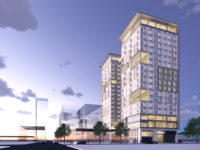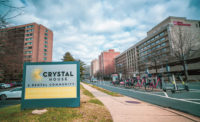The City of Oakland, California, is moving forward with plans for redevelopment of the Howard Terminal, including a new stadium for the Oakland Athletics, after releasing a final Environmental Impact Report on Dec. 17, but not without pushback from residents and community groups.
Last year, the Oakland City Council adopted a preliminary, non-binding agreement with the African American Sports Entertainment Group (AASEG), a Bay Area business group that advocates for economic equity for the Black community through sports and entertainment, for a 35,000-person capacity Major League Baseball park. The A’s current home is the 100-acre RingCentral Coliseum site, and John J. Fisher is the A’s majority owner.
The new Howard Terminal project site, at a separate location from the RingCenter Coliseum, is approximately 55 acres that includes the Charles P. Howard Terminal and adjacent parcels, located at the Port of Oakland along the Inner Harbor of the Oakland-Alameda Estuary. The plan includes the stadium, 3,000 housing units, up to 1.77 million square feet of commercial development, a 400-room hotel, and a new performance 3,500 person capacity venue.
The agreement requires that 15% of the housing units in conjunction with the Howard Terminal project be affordable; and that the A’s contribute $50 million to support a combination of new, off-site units, preservation and/or renovation of existing units in the surrounding neighborhoods, and down payment assistance. The developers would also provide funding to the city to enhance anti-displacement tenant services.
Oakland’s final environmental impact report does not detail the number of residents potentially displaced and does not describe the affordability level of the 3,000 units. The report says the development will have an affordable housing program in compliance with city requirements, which may include on-site or offsite affordable housing units and/or the payment of impact fees.
“Gentrification often leads to displacement. We would like to give priority to people to move back to Oakland who left Oakland over the last 20 years and who were priced out,” says Ray Bobbitt, founder and president of AASEG, without citing specifics. Twenty eight percent of Oakland’s residents identify as white alone; 24% Black; 27% Hispanic and 16% Asian, according to the U.S. Census Bureau, with 16.7% of Oakland’s population living in poverty.
Community residents and organizations, including the Oakland Tenants Union, Oakland Rising, Restaurant Opportunities Center of the Bay, the Oakland Asian Cultural Center (OACC), and others expressed concerns about the lack of clarity about affordable housing, toxic site clean-up and increased air pollution.
“The Howard Terminal site is currently so contaminated with toxic materials that it is illegal to build housing there,” and the plan lacks specifics for a clean-up, said OTU in the EIR’s public comment. OTU said the project will have significant impact on air quality in a city that historically has been one of the most polluted in California, with disproportionately high levels of air pollution related diseases like asthma, cancer, heart disease and stroke.
Meanwhile, OACC said the project will replace Oakland’s Chinatown, an authentic Chinese and Eastern Asian community, with gentrification. “The project threatens Chinatown’s very existence because it creates traffic that will choke off access to Chinatown by people who would patronize local business and restaurants.”
Affordable Housing Lags Statewide
Oakland's struggle is endemic of California’s struggle to meet affordable housing needs across the state. With the state's record median housing price of $782,480 for a single family home, according the California Association of Realtors, California’s notorious housing shortage is deep in crisis, with development sprawling deeper into historically low-income areas, displacing and outpricing long-term residents. Compounding the urgency is the need for not only affordable but sustainable housing to counter to protect from climate change’s and pollution’s effects.
“Keeping people housed and meeting their basic needs is fundamental to the resilience of any community,” says Heather Rosenberg, an associate principal and Los Angeles resilience leader at Arup. Rosenberg has no connection and is not familiar with the Howard Terminal project. “Without affordable housing, we run the risk of displacement, especially as we think about the impacts of housing shortages, stagnating wages, and events such as COVID-19 and climate events."
The California housing shortage is particularly acute in the affordable and middle-income ranges, and Rosenberg notes that, despite that urgent need, much of new development targets the luxury market because of its higher return on investment for developers.
Median rent increased 35% since 2000, but median renter household income has increased just 6%; renters must earn nearly 3 times California’s $14 per hour minimum wage to afford average rents, according to the California Housing Partnership, an affordable housing advocacy group.
The partnership estimates that California needs 1.2 million more affordable homes by 2030, or 120,000 per year, to meet demand. In 2020, only 16,698 affordable housing units were built.
“But at a society level, the return on public investment in affordable housing is much higher,” says Rosenberg. “The social cost of displacement is massive, so building more affordable housing, preserving existing units, and keeping them affordable and fit for purpose have a high social ROI.” Arup is currently working on methodologies to calculate the social ROI in order to better inform policy and program design.
Existing communities often oppose affordable housing developments, concerned with density and traffic. “But denser housing, primarily affordable housing centered around transit and connected to jobs and schools, is essential and would solve a whole range of interconnected issues,” says Rosenberg, pointing to growing opportunities for increasing value and wealth for tenants that include new ownership structures, co-ops, and land trusts. “The challenge that many renters face is that they don’t build equity. They pay rent for years that can’t be applied towards a down payment or deposit. So how can tenants build equity so that they can move out of a cycle of poverty and build wealth?”
Addressing the twin problems of displacement and disinvestment by acquiring and stewarding community-controlled land could help, along with better outreach, stronger requirements, and more accessible financing are needed, as are better ways to communicate the value of affordable housing to communities. “And of course, housing is expensive,” Rosenberg says. “More public investment is essential.”
Christine Kilpatrick contributed to this article.






Post a comment to this article
Report Abusive Comment